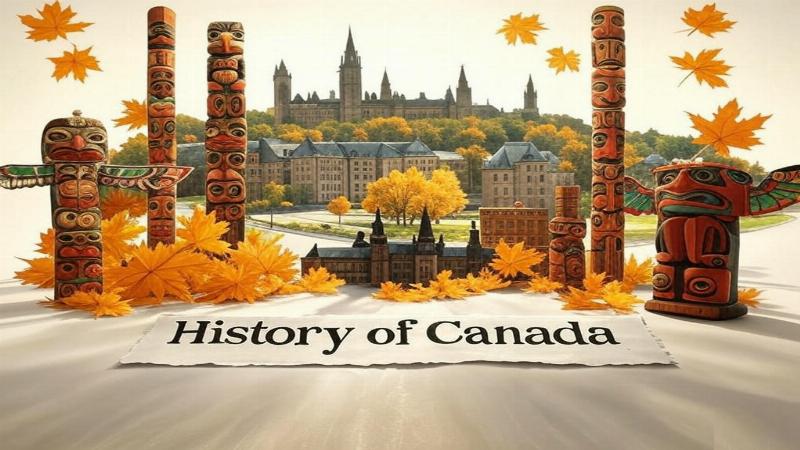Place for ads

Canada, a vast nation spanning the northern reaches of North America, is a land where icy tundras, dense forests, and sprawling prairies tell a story of resilience and growth. Covering 9,984,670 square kilometers, it stretches from the Atlantic to the Pacific and the Arctic, bordered only by the United States. Known today for its maple syrup, hockey, and multicultural mosaic, Canada’s history blends ancient Indigenous traditions, colonial rivalries, and modern nation-building. In this article, we’ll trace Canada’s past, from its earliest days to its contemporary identity, uncovering the milestones that have shaped this remarkable country.
Canada’s human story begins around 30,000 BCE, when Ice Age hunters crossed from Siberia via the Bering Land Bridge—Clovis points from Bluefish Caves in Yukon date to 24,000 BCE. These Paleo-Indians tracked mammoths across a frozen landscape, their descendants spreading coast to coast.
By 5000 BCE, Archaic cultures thrived—Inuit ancestors hunted seals in the Arctic, while Algonquian and Iroquoian peoples fished and farmed in the east. The Haida of the Pacific Northwest carved totem poles, and Plains Cree followed bison. By 1000 CE, over 50 languages flourished—Canada’s Indigenous nations numbered 500,000 when Europeans arrived.
Place for ads
Around 1000 CE, Norse explorers from Greenland, led by Leif Erikson, landed at L’Anse aux Meadows in Newfoundland—wooden shelters and iron nails mark their brief stay, the first European footprint in North America. They left, and Indigenous life continued—Haudenosaunee (Iroquois) formed a confederacy, while Mi’kmaq fished the Atlantic.
Trade networks linked nations—copper from the Great Lakes reached the Gulf of Mexico, wampum beads the northeast. The Thule (ancestors of modern Inuit) spread east, mastering whale hunts with kayaks. These societies, rich in oral tradition, thrived until the Age of Exploration disrupted their world.
In 1497, John Cabot claimed Newfoundland for England, but France dominated early—Jacques Cartier sailed the St. Lawrence in 1534, naming “Canada” from the Iroquoian word “kanata” (village). Samuel de Champlain founded Quebec City in 1608, birthing New France—fur trade with Huron allies fueled it.
Britain countered—Hudson’s Bay Company (1670) claimed Rupert’s Land, trading beaver pelts. The 1756–1763 Seven Years’ War tipped the scales—Britain’s 1759 victory on Quebec’s Plains of Abraham ended French rule. The 1763 Treaty of Paris ceded Canada to Britain, though Quebec’s French culture endured.
The 1776 American Revolution reshaped Canada—Loyalists fled north, swelling Nova Scotia and Ontario. The 1791 Constitutional Act split Quebec into Upper (English) and Lower (French) Canada, granting assemblies. The War of 1812—U.S. invasions repelled at Queenston Heights—solidified British ties.
The 1837–1838 Rebellions—led by Louis-Joseph Papineau and William Lyon Mackenzie—demanded reform. Britain merged the Canadas in 1841 under the Act of Union, but Responsible Government in 1848 gave locals control. Railways and timber boomed—Canada West grew, eyeing a broader union.
On July 1, 1867, the British North America Act united Ontario, Quebec, New Brunswick, and Nova Scotia as the Dominion of Canada—John A. Macdonald became its first prime minister. Ottawa, a lumber town, rose as capital. The Canadian Pacific Railway (1885) linked east to west, spurring growth.
Expansion followed—Manitoba joined in 1870 after Louis Riel’s Red River Rebellion, securing Métis rights. British Columbia (1871) and Prince Edward Island (1873) signed on, while the Northwest Territories stretched north. The 1885 Riel-led North-West Rebellion failed—his execution deepened French-English divides.
Canada matured—gold rushes in Yukon (1898) and homesteading in Saskatchewan (1905) drew settlers. World War I forged a national spirit—60,000 died at Vimy Ridge (1917), earning autonomy via the 1931 Statute of Westminster. Prairie wheat and Ontario factories fueled an industrial boom.
World War II saw 45,000 fall—Dieppe (1942) scarred, but D-Day (1944) triumphed. Post-war, Newfoundland joined in 1949, completing Canada’s map. Lester Pearson’s 1960s leadership brought the maple leaf flag (1965) and universal healthcare—immigration from Asia and the Caribbean began reshaping the nation.
Today, Canada’s 38 million people span a global mosaic—Pierre Trudeau’s 1971 multiculturalism policy welcomed all. Quebec’s 1980 and 1995 sovereignty votes failed, but French identity thrives—Bill 101 guards language. The 1982 Constitution Act patriated governance, adding a Charter of Rights.
Oil sands in Alberta and tech in Toronto drive wealth—Canada’s G7 status shines—but Indigenous reconciliation lags—residential school graves (2021) spurred apologies. Climate change melts the Arctic; wildfires rage—yet hockey, poutine, and Banff’s peaks define a proud identity.
Canada’s history is a North American epic—from Indigenous trails to colonial forts, confederation to modern vibrance. Its lakes echo ancient songs, its cities hum with hope. As Canada strides forward, its past fuels a legacy of unity and strength.
Place for ads